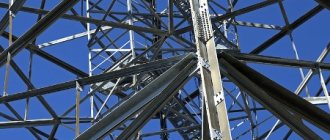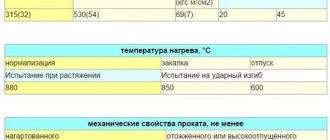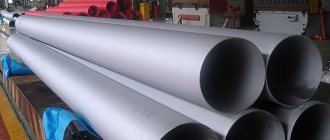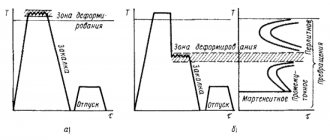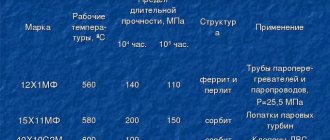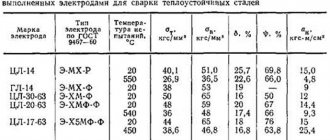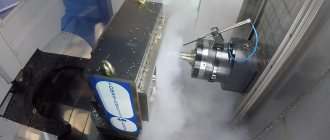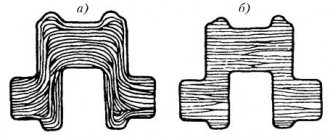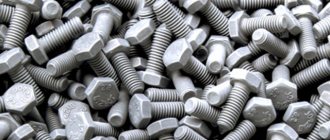Steel marking expresses the chemical composition and properties of the metal, allows you to differentiate products by quality, purpose, deoxidation and other characteristics. Knowledge of these properties allows you to correctly use steel when obtaining rolled products, selecting grades according to the required characteristics of the final product and the conditions under which it will be used. Therefore, the primary designations in order to distinguish one type of steel from another appeared even before the start of mass industrial smelting in the 19th century.
In general, a wide range of steel grades makes it possible to create and produce rolled products with the required set of characteristics - for various features of further use. At the same time, the manufacturer is required to strictly adhere to the specified physical and chemical parameters of the brand so that the operation of products made from it occurs as usual, without deviations or unforeseen events. The parameters of each brand are recorded in the relevant national standards and regulatory documentation of manufacturers.
At the same time, different countries and their associations have different labeling systems, and in some countries there are several systems at the same time (for example, in the USA). The European Union, China, Japan, the CIS, and Ukraine have historically developed their own systems. The differences between these systems sometimes make it difficult to select the right steels for the final product. The implementation of EU standards taking place in Ukraine simplifies this task. In general, over 1,500 different grades of steels and alloys are known in the world today for a variety of purposes and operating conditions. Most likely, in the future, with the development of metal application technologies, new varieties of alloys involving new materials will appear, and the number of grades will increase.
Designation of steels in Ukrainian and CIS standards
In the state standards of Ukraine (DSTU) and CIS countries (GOST) there is an alphanumeric system for designating steel and alloy grades, where the names of chemical elements and steel smelting techniques are expressed in letters, and the content of elements is expressed in numbers. Letter designations are also used to indicate the deoxidation method (kp - boiling steel, ps - semi-calm, sp - calm). Separate groups of steels are marked in a special way - construction, structural, stainless, tool, etc.
Unalloyed structural steels of ordinary quality (GOST 380, DSTU 2651) are designated as Art., example - Art. 3. The number after the letters characterizes the conditional percentage of carbon. In turn, the marking of structural unalloyed quality steels (GOST 1050, DSTU 7809) is a two-digit number showing the average carbon content in hundredths of a percent (say, 10).
High-quality steels for boilers and high-pressure vessels in accordance with GOST 5520 and DSTU 8804 are marked as structural non-alloy steels, but with the addition of the letter K (for example, 20K).
Structural alloy steels according to GOST 4543 and DSTU 7806 are designated by letters and numbers. The numbers after each letter are the approximate content of the corresponding element (but if the indicator is less than 1.5%, then the number is not included). Additional quality parameters (reduced content of impurities such as sulfur and phosphorus) are indicated by the letter A or Ш at the end of the designation, for example - 12ХНЗА, 18ХГ-Ш. Cast structural steels (GOST 977, DSTU 8781) are designated in the same way as high-quality and alloyed steels, but with the letter L at the end of the name.
Designation of the main alloying elements when marking steels according to GOST/DSTU
| A (in the middle of the marking) – nitrogen | N – nickel |
| B – niobium | R – boron |
| B – tungsten | C – silicon |
| G – manganese | T – titanium |
| D – copper | F – vanadium |
| E – selenium | X – chrome |
| K – cobalt | C – zirconium |
| M – molybdenum | Yu – aluminum |
In particular, adding chromium and nickel to steel improves its strength characteristics and imparts corrosion resistance, cobalt increases heat resistance and impact resistance, and niobium improves hardness, fatigue strength and weldability.
Construction steels, according to DSTU 8539/GOST 27772, are marked with the letter C and numbers illustrating the minimum yield strength. Additionally, there are the following designations: T - heat-strengthened rolled steel, K - increased corrosion resistance (say, S345T, S390K), D - increased copper content.
Unalloyed tool steels according to GOST 1435 are divided into
- qualitative: indicated by the letter U and the number of average carbon content (U7, U8, U10);
- high-quality, with an additional letter A at the end of the brand (for example, U8A) or an additional letter G, indicating a high manganese content (for example, U8GA).
Alloyed tool steels (DSTU 3833, GOST 5950) are marked in the same way as alloyed structural steels (4Х2В5МФ, etc.).
Further, in the formulation of the grade, high-speed steels are assigned the letter P (at the very beginning), then there is a figure for the average proportion of tungsten in the composition, after that there are letters and numbers reflecting the mass content of the elements. However, the content of chromium (it is stable, about 4% in all high-speed steels) and carbon (it is always proportional to the vanadium content) is not indicated. On the other hand, if the vanadium content is >2.5%, the letter F and a number are given (Р6М5, Р6М5Ф3, etc.).
Standard stainless steels (GOST 5632) are marked with letters and numbers in the same way as structural alloy steels (say, 08Х18Н10Т or 16Х18Н12С4ТУЛ).
The naming of automatic steels (GOST 1414) begins with the letter A; if the steel is alloyed with lead - then with the letters AC. To show the content of alloying additives, markings similar to structural steels are used.
Electrical steels are designated by the letter E, the first number indicates the silicon content, the second number indicates the electrical properties. Thus, E21 is electrical steel containing 2% silicon and about 0.1% carbon.
Steel brand
Heat-resistant alloy
|
|
|
|
|
|
|
|
|
|
|
|
|
|
Carbon tool steel
|
|
|
|
|
|
|
|
|
|
|
|
|
|
|
|
|
|
|
|
Casting steel, corrosion-resistant
|
|
|
|
|
|
|
|
|
|
|
|
|
|
|
|
|
|
|
|
|
|
|
|
|
|
|
|
|
Ordinary steel for castings
|
|
|
|
|
|
|
|
|
|
|
|
|
|
|
|
|
|
|
|
|
|
|
|
|
|
|
|
|
|
|
|
|
|
|
|
|
|
|
|
|
|
|
|
|
|
|
|
|
|
|
|
|
|
|
|
|
|
|
|
|
|
|
|
|
|
|
|
|
|
|
|
|
|
|
|
|
|
|
|
|
|
High-alloy heat-resistant steel
|
|
|
|
|
|
|
|
|
|
|
|
|
|
|
|
|
|
|
|
|
|
|
|
|
|
|
|
|
|
|
|
|
|
|
|
|
Low-alloy heat-resistant steel
|
|
|
|
|
|
|
|
Heat-resistant, relaxation-resistant steel
|
|
|
|
|
|
|
|
|
|
Alloy tool steel
|
|
|
|
|
|
|
|
|
|
|
|
|
|
|
|
|
|
|
|
|
|
|
|
|
|
|
|
|
|
|
|
|
|
|
|
|
|
|
|
|
|
|
|
|
|
Die tool steel
|
|
|
|
|
|
|
|
|
|
|
|
|
|
|
|
|
|
|
|
|
|
|
|
|
|
|
|
|
|
|
|
|
|
|
|
|
|
|
|
|
|
|
|
|
|
|
|
|
|
|
|
|
|
|
|
High-speed tool steel
|
|
|
|
|
|
|
|
|
|
|
|
|
|
|
|
|
|
|
|
|
Rolling tool steel
|
|
|
|
|
|
|
|
|
|
|
|
|
|
|
|
|
|
|
|
|
|
|
|
|
|
|
Alloy structural steel
|
|
|
|
|
|
|
|
|
|
|
|
|
|
|
|
|
|
|
|
|
|
|
|
|
|
|
|
|
|
|
|
|
|
|
|
|
|
|
|
|
|
|
|
|
|
|
|
|
|
|
|
|
|
|
|
|
|
|
|
|
|
|
|
|
|
|
|
|
|
|
|
|
|
|
|
|
|
|
|
|
|
|
|
|
|
|
|
|
|
|
|
|
|
|
|
|
|
|
|
|
|
|
|
|
|
|
|
|
|
|
|
|
|
|
|
|
|
|
|
|
|
|
|
|
|
|
|
|
|
|
|
|
|
|
|
|
|
|
|
|
|
|
|
|
|
|
|
|
|
|
|
|
|
|
|
|
|
|
|
|
|
|
|
|
|
|
|
|
|
|
|
|
|
|
|
|
|
|
|
|
|
|
|
|
|
|
|
|
|
|
|
|
|
|
|
Low-alloy structural steel for welded structures
|
|
|
|
|
|
|
|
|
|
|
|
|
|
|
|
|
|
|
|
|
|
|
|
|
|
|
|
|
|
|
|
|
|
|
|
|
|
|
|
|
|
|
|
|
|
|
|
|
|
|
|
|
|
|
|
|
|
|
|
|
|
|
|
|
|
|
|
|
|
|
|
|
|
|
|
|
|
|
|
|
|
|
|
|
|
|
|
|
|
|
|
|
|
|
|
|
|
|
|
|
|
|
|
|
|
|
|
|
|
|
Structural steel with increased machinability
|
|
|
|
|
|
|
|
|
|
|
|
|
|
|
|
|
|
|
|
|
|
|
|
|
|
|
|
Structural bearing steel
|
|
|
|
|
|
|
Structural spring steel
|
|
|
|
|
|
|
|
|
|
|
|
|
|
|
|
|
|
|
|
|
|
|
|
|
|
|
|
|
|
|
|
|
|
|
|
Quality carbon structural steel
|
|
|
|
|
|
|
|
|
|
|
|
|
|
|
|
|
|
|
|
|
|
|
|
|
|
|
|
|
|
|
|
|
|
|
|
|
|
|
|
|
|
|
|
|
|
|
|
|
|
|
|
|
|
|
|
|
|
|
|
|
|
|
|
|
|
|
|
|
|
|
|
|
|
|
|
|
|
|
|
|
|
|
|
|
|
Structural carbon steel of ordinary quality
|
|
|
|
|
|
|
|
|
|
|
|
|
|
|
|
|
|
|
|
|
|
|
|
|
|
|
|
|
|
|
|
|
|
|
|
|
|
|
|
|
|
|
|
|
|
|
|
|
|
|
|
|
|
|
|
|
|
|
|
|
|
|
|
|
|
|
|
|
Corrosion-resistant, heat-resistant steel
|
|
|
|
|
|
|
|
|
|
|
|
|
Corrosion-resistant ordinary steel
|
|
|
|
|
|
|
|
|
|
|
High alloy cast iron
|
|
|
|
|
|
|
|
|
|
|
|
|
|
|
|
|
|
|
|
|
|
|
|
|
|
|
Malleable cast iron
|
|
|
|
|
|
Cast iron foundry
|
|
|
|
|
|
|
|
|
|
|
|
|
Low alloy cast iron
|
|
|
|
|
|
|
|
|
|
|
|
Pig iron
|
|
|
|
|
|
|
|
|
|
Gray cast iron
|
|
|
|
|
|
Marking of steels according to European standards
According to part 1 of the European standard EN 10027 and its Ukrainian version DSTU EN 10027, according to the order of naming, steels are differentiated into 2 groups.
Group 1 unites steels, the grades of which depend on their purpose, as well as physical or mechanical properties. Grades consist of one or more letters that indicate the purpose of the steel, followed by numbers that describe the properties. The numbers may contain symbols that identify the delivery status and the purpose of the product. For example, the S355J0 marking indicates a structural steel with a minimum yield strength of 355 N/mm2 and a work of fracture on impact of 27 J, measured at 0°C.
Group 2 includes steels whose grades are determined by their chemical composition. This group is divided into subgroups according to the purpose and content of alloying elements. Thus, 13CrMo4-5 is an unalloyed steel with an average content of 0.13% carbon, 1% chromium, 0.5% molybdenum and more than 1% manganese.
In addition to basic markings, steels according to European standards have serial numbers. The procedure for their assignment is determined by the European standard EN 10027-2 and the Ukrainian DSTU EN 10027-2. The serial number of steel is presented in the form “1.XXXX”, where “1.” demonstrates that the material belongs to steels, the next two digits are the number of the steel group, and the last two are the serial number of the steel in the group. By the group number you can clearly determine the type of steel.
Types of steels and features of their markings
Steel is an alloy of iron and carbon, the content of which is no more than 2.14%. Carbon gives the alloy hardness, but if it is in excess, the metal becomes too brittle.
One of the most important parameters by which steels are divided into different classes is the chemical composition. Among the steels according to this criterion, alloyed and carbon steels are distinguished, the latter are divided into low-carbon (carbon up to 0.25%), medium-carbon (0.25–0.6%) and high-carbon (they contain more than 0.6% carbon).
Types of steels
By including alloying elements in the steel, it can be given the required characteristics. It is in this way that, by combining the type and quantitative content of additives, grades with improved mechanical properties, corrosion resistance, magnetic and electrical characteristics are obtained. Of course, it is possible to improve the characteristics of steels using heat treatment, but alloying additives make it possible to do this more efficiently.
Based on the quantitative composition of alloying elements, low-, medium- and high-alloy alloys are distinguished. In the first alloying elements there is no more than 2.5%, in medium alloyed elements - 2.5–10%, in highly alloyed ones - more than 10%.
Steels are classified according to their purpose. Thus, there are instrumental and structural types, grades distinguished by special physical properties. Tool types are used for the production of stamping, measuring, and cutting tools, structural ones - for the production of products used in construction and mechanical engineering. Alloys with special physical properties (also called precision) are used to make products that must have special characteristics (magnetic, strength, etc.).
Classification of steels by purpose
Steels are also contrasted with each other based on their special chemical properties. Alloys of this group include stainless, scale-resistant, heat-resistant, etc. Typically, stainless steels can be corrosion-resistant and stainless steel for food - these are different categories.
In addition to useful elements, steel also contains harmful impurities, the main ones of which are sulfur and phosphorus. It also contains gases in an unbound state (oxygen and nitrogen), which negatively affects its characteristics.
If we consider the main harmful impurities, phosphorus increases the brittleness of the alloy, which is especially pronounced at low temperatures (the so-called cold brittleness), and sulfur causes cracks in metal heated to high temperatures (red brittleness). Phosphorus, among other things, significantly reduces the ductility of heated metal. Based on the quantitative content of these two elements, steels are divided into ordinary quality (no more than 0.06–0.07% sulfur and phosphorus), high-quality (up to 0.035%), high-quality (up to 0.025%) and especially high-quality (sulfur - up to 0.015%, phosphorus - up to 0.02%).
The marking of steels also indicates to what extent oxygen has been removed from their composition. According to the level of deoxidation, steels are divided into:
- calm type, designated by the letter combination “SP”;
- semi-calm - “PS”;
- boiling - “KP”.
Steel marking according to American standards
In the USA, several systems for marking metals and alloys are used; these systems are associated with various standardization agencies. The most famous are AISI - American Iron and Steel Institute, ACI - American Casting Institute, ANSI - American National Standards Institute, AMS - Aerospace Materials Specification, ASME - American Society of Mechanical Engineers, ASTN1 - American Society for Testing Materials, AWS - American Welding Society, SAE – Society of Automotive Engineers. The designations used by organizations stem from the history of their work as well as the development of correlated industries.
In particular, in the AISI marking, carbon and alloy steels are usually designated using 4 digits. The first two digits indicate the steel group number, the next two indicate the average carbon content multiplied by 100. In addition to numbers, steel grades may contain letters. Moreover, the letters B and L, indicating doping with boron (0.0005-0.03%) or lead (0.15-0.35%), respectively, are placed between the 2nd and 3rd digits of the brand, for example, 51B60, 15L48. Whereas the letters M and E are placed at the beginning of the designation if the steel is intended for the production of non-critical rolled products (M) or is produced in an electric furnace (E). Along with this, the letter H may be present at the end of the brand formula, indicating that the characteristic property of this steel is hardenability.
AISI grades of standard corrosion-resistant steels include three numbers and then, in some cases, one, two or more letters. The first of the numbers determines the class of steel: thus, grades of austenitic corrosion-resistant steels begin with the numbers 2ХХ and 3ХХ, while ferritic and martensitic steels are determined by the formula 4ХХ. Please note that the last two digits - unlike carbon and alloy steels - are in no way related to the chemical composition, but simply indicate the serial number of the steel in the group.
Marking according to ASTM standards includes the letter A (i.e. we are talking about ferrous metal), the serial number of the ASTM regulatory document (standard), and the actual wording of the brand. Usually within the framework of ASTM there is an American system of physical quantities, but if the standard uses the metric system of notations, the letter M is entered after its number. ASTM standards most often determine not only the chemical composition of steel, but also the full range of product requirements. To indicate the actual grades and their chemical composition, both ASTM designations can be used (when the chemical composition and marking are determined directly in the standard), and those borrowed from other systems, say, from AISI - for rods, wires, from ACI - for castings made of corrosion-resistant steels.
UNS is a universal marking system for metals and alloys. It was developed in 1975 to unify various labeling systems in the United States. In UNS, steel grades include letters indicating the steel group and five numbers. According to UNS principles, the easiest way to classify steels is from the AISI system. Thus, for structural and alloy steels included in group G, the first four digits of the formula are the name in AISI, while the last digit replaces the letters found in AISI. In particular, the letters B and L, indicating alloying with boron or lead, correspond to numbers 1 and 4, and the letter E (the product is smelted in an electric furnace) corresponds to number 6. Grades of corrosion-resistant AISI steels begin with the letter S and include the AISI steel designation (the first three digits) and two additional numeric values corresponding to the additional letters in AISI.
Correspondence between AISI and UNS characters
| AISI symbol | XXXL | XXXS | XXXN | XXXLN | XXXF | XXXSe | XXXB | XXXH | XXXCu |
| UNS symbol | XXX01 | XXX08 | XXX51 | XXX53 | XXX20 | XXX23 | XXX15 | XXX09 | XXX30 |
What does the steel marking mean?
It has become quite easy to decipher the brand; you just need to have certain information. Structural steels of ordinary quality and not containing alloying elements are marked with the letter combination “St”. By the number following the letters in the name of the brand, you can determine how much carbon is in such an alloy (calculated in tenths of a percent). The numbers may be followed by the letters “KP”: from them it becomes clear that this alloy has not completely gone through the deoxidation process in the furnace, and accordingly, it belongs to the boiling category. If the brand name does not contain such letters, then the steel corresponds to the calm category.
Chemical composition of carbon structural steels of ordinary quality
Structural unalloyed steel, which belongs to the quality category, has two numbers in its designation; they are used to determine the average carbon content in it (calculated in hundredths of a percent).
Before we begin to consider the grades of those steels that include alloying additives, you should understand how these additives are designated. Marking of alloy steels may include the following letter designations:
List of alloying additives used
Shipbuilding steel grades
Steels for shipbuilding are marked according to the standards of the International Association of Classification Societies (IACS). In international practice, unified categories of hull steels (A, B, D, E, F) are adopted, characterized by yield strength and impact work at different temperatures. The letter illustrates impact characteristics: steel grade (category) A is not tested for impact bending, B, D, E and F must provide a certain impact work at test temperatures of 0°C, -20°C, -40°C, -60, respectively °C. If there is no number after the letter definition, the steel has normal strength (yield strength of at least 235 MPa or 24 kgf/mm2). High-strength steels are followed by numbers 32, 36 or 40, indicating a minimum yield strength of 315, 355 or 390 MPa, respectively.
The mechanical characteristics of ship hull steels of normal and high strength are determined by international maritime registers BV, ABS, DNV, RINA, etc., national and interstate standards.
Marking of steels in Russia [edit | edit code ]
Deciphering steel grades requires knowing what letters are used to denote certain chemical elements that make up the grade or alloy.
If at the very end of the mark there is a letter A, then this means high-quality steel, the content of phosphorus and sulfur in which is minimized (S [6]:
- "kp" - boiling
- "ps" - semi-calm
- "sp" - calm
Non-standard steels are designated differently. Thus, experimental grades smelted at are designated by the letter I (research) and P (trial) and a serial number, for example, EI179, EI276, EP398, etc. Experimental grades smelted at a metallurgical plant are designated DI 80, where D is the plant -manufacturer, I - research, 80 - serial number assigned to the steel grade.
How to decipher steel markings
In order to determine what type of alloy is used, it is necessary to use a reference book, which contains a table with a breakdown of the steel grade. Let's look at some examples indicating markings and their designation:
- U8GA indicates that the mechanism uses a material with a carbon composition of up to 0.8%, with the addition of manganese particles;
- deciphering the HVG marking will not be difficult; the design of the mechanism should use an alloy with the addition of chromium, tungsten and manganese up to 1%;
- Welded structures are made from St3sp5 - fully deoxidized steel, unalloyed, calm, the number 5 indicates the category.
Having some knowledge when choosing a material will help you understand the technical characteristics of steel alloys. At the same time, possible errors and malfunctions of mechanisms can be prevented.
